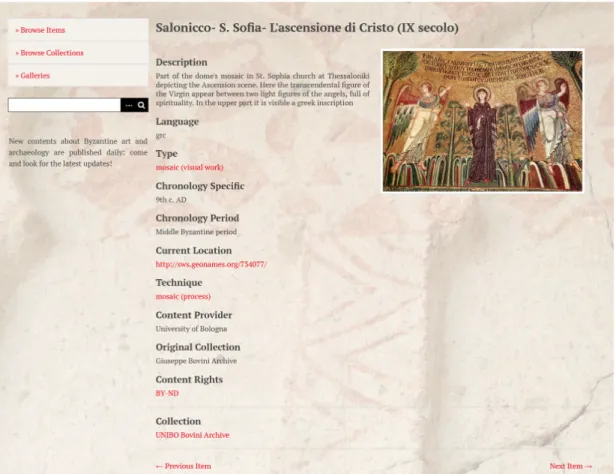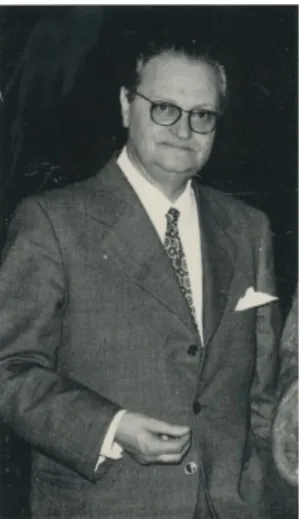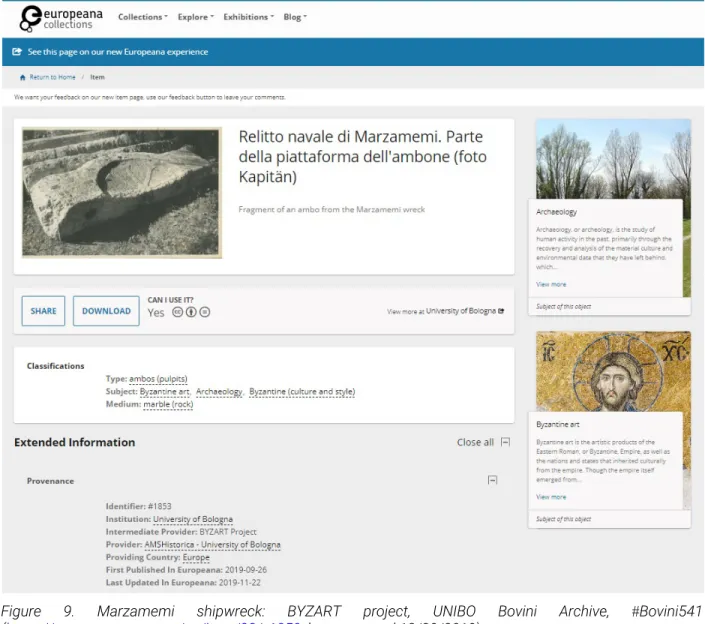HAL Id: halshs-02906325
https://halshs.archives-ouvertes.fr/halshs-02906325
Submitted on 24 Jul 2020
HAL is a multi-disciplinary open access
archive for the deposit and dissemination of sci-entific research documents, whether they are pub-lished or not. The documents may come from teaching and research institutions in France or
L’archive ouverte pluridisciplinaire HAL, est destinée au dépôt et à la diffusion de documents scientifiques de niveau recherche, publiés ou non, émanant des établissements d’enseignement et de recherche français ou étrangers, des laboratoires
Lucia Maria Orlandi, Giulia Marsili
To cite this version:
Lucia Maria Orlandi, Giulia Marsili. Digital Humanities and Cultural Heritage Preservation: The Case of the BYZART (Byzantine Art and Archaeology on Europeana) Project. Studies in Digital Heritage, Virtual World Heritage Lab at Indiana University, 2019, 3 (2), pp.144-155. �10.14434/sdh.v3i2.27721�. �halshs-02906325�
research field, and new projects and opportunities are constantly flourishing. The BYZART project perfectly fits this context. This project was coordinated by the Department of History and Cultures of the University of Bologna, embracing a wide consortium of partners from Bulgaria, Greece and Italy. It aimed at enhancing Byzantine and Post-Byzantine artistic and cultural heritage within the Europeana platform. This project enriched the existing Europeana collections with about 75,000 new cultural and artistic multimedia objects relevant to Byzantine history and culture, including collections of digitized photos, video and audio content. We also established a liaison between the new materials and Byzantine-related content already existing on
Europeana. The archival material collected and digitized by the BYZART consortium is of the greatest
cultural and art-historical importance, but it had not been properly evaluated or published before. For this reason, BYZART aimed to guarantee the preservation and evaluation of significant cultural heritage objects from a wide range of contexts, while also making them accessible to scholarly and general audiences alike.
Key words:
Byzantine cultural heritage, archaeology, archives, Europeana, preservation, dissemination.
SDH Reference:
Giulia Marsili et al. 2019. Digital Humanities and Cultural Heritage Preservation: The Case of the BYZART (Byzantine Art and Archaeology on Europeana) Project. SDH, Vol. 3, No. 1, 11 pages. DOI: 10.14434/sdh.v3i2.27721
1. INTRODUCTION
The latest improvements in Information Technology and the Digital Humanities have led to numerous and significant developments in the field of Cultural Heritage and have contributed to many new interventions and opportunities [Gold 2012; Foka et al. 2017]. Some remarkable innovations belong to the field of archaeology, which is increasingly nurtured by the digital content and by new
The work for this article has been carried out in the framework of the project BYZART, which is funded from the CEF Program-Europeana Generic Services 2016 (Program-Europeana Action n. 2016-EU-IA-0094).
Author's address: Giulia Marsili, Department of History and Cultures, University of Bologna, P.za San Giovanni in Monte 2, 40124, Bologna, Italy; email: giulia.marsili2@unibo.it; Lucia Maria Orlandi, Department of History and Cultures, University of Bologna, P.za San Giovanni in Monte 2, 40124, Bologna, Italy; email: luciamaria.orlandi3@unibo.it
© 2019 by the authors; licensee Studies in Digital Heritage, IU, Bloomington (IN), USA. This article is an open access article distributed under the terms and conditions of the Creative Commons Attribution License (CC BY-NC).
media and modes of Cultural Heritage representation [Eiteljorg 2004; Dunn et al. 2012; Nygren et al. 2016; Foka, Westin, and Chapman 2018]. The documentation, preservation, publication, and enhancement of the cultural and artistic heritage can now be accomplished in a wide variety of ways, from digital libraries to fully operational 3-D models, which can be exported, used, and exploited by a large audience.1 BYZART fits this context perfectly. The project was undertaken over 18 months (from
October 2017 to April 2019) and was co-financed by the European Commission as part of the Connecting Europe Facility (CEF) program, which aims to develop high-performance, sustainable, and interconnected trans-European networks in the field of digital services, among others.2
Europeana is a European digital library for Cultural Heritage and has been online since 2009.3 This
infrastructure was implemented in order to create the largest online platform for the dissemination, enhancement, and publication of Cultural and Scientific Heritage from Prehistory to the present day. More than 50 million digitized items in 30 languages and from various institutions within the 28 member countries of the EU are currently gathered and displayed on Europeana. Among the partner institutions are some of the most important European museums and libraries, regional archives, and local museums. The digital content includes texts, works of art, photographs, journals, maps, manuscripts, audio, and audio-visual archival materials. The main targets are research, education, culture, and the creative industries (Fig. 1).
Figure 1. Europeana structure, activities, and stakeholders, © Europeana CC BY-SA).
In order to reach the various categories of users, Europeana has recently launched several Thematic Collections dedicated to different topics, such as Art, Archaeology, Fashion, Music, Photography, Geography, Sport, Natural History, and WWI (Fig. 2). Within each collection, the users can carry out thorough queries. At the same time, galleries with selected images, temporary and permanent web-exhibitions, blogs with edited content, and other updates facilitate browsing.
1 https://www.frontiersin.org/journals/digital-humanities#; https://www.millionimage.org.uk/; http://www.carare.eu/ 2 https://ec.europa.eu/inea/en/connecting-europe-facility
Figure 2. Homepage of Europeana Collections website (https://www.europeana.eu/portal/en, last accessed: 12/30/2019).
2. THE BYZART PROJECT
The BYZART project aimed towards the digitization and online publication of new material about Byzantine and Post-Byzantine archaeological and artistic heritage, a milestone of European Cultural heritage, via Europeana. The project was coordinated by the Department of History and Cultures of the University of Bologna (Prof. Isabella Baldini) and embraced a large consortium of partners, such as the Ionian University of Kerkyra, the Aristotle University of Thessaloniki, the Institute of Art Studies of the Bulgarian Academy of Sciences, the Historical Research Institute at the National Hellenic Research Foundation, the Open University in Cyprus, the Museum of the City of Ravenna with the Mosaic Documentation Center and the Biblioteca Classense. Almost all the partners were data providers and have digitized and shared rich collections of cultural heritage objects (Fig. 3). The BYZART project enriched the existing Europeana collections with about 75,000 new cultural and artistic items in diverse media, including digitized photo, video, and audio collections, as well as 3-D surveys and reconstructions relevant to Byzantine history and culture. We also established a liaison between the new materials and Byzantine-related content already existing on Europeana. The archival material collected and digitized by the BYZART consortium is of the greatest cultural and art-historical importance, but it had not been properly evaluated or published before. For this reason, BYZART aimed to guarantee the preservation and evaluation of significant cultural heritage objects from a wide range of contexts, while also making them accessible to scholarly and general audiences alike.
Figure 3. The BYZART Project website homepage: photograph from BYZART’s Kick-off Meeting (https://byzart.eu/partners, last accessed 01/30/2019).
“Revealing” Byzantine Cultural Heritage Objects to the Audience: the
BYZART Web Database
Due to the fragmentary nature and differing storage conditions of the archives, the project team strategically developed a classification system to inventory and catalog the vast assortment of items contained in the collections.
The archival sources linked to the BYZART project gather various and completely unpublished collections (Fig. 4): the Giuseppe Bovini collection (Department of History and Cultures, University of Bologna); sections of the Federico Zeri photographic archive (Federico Zeri Foundation, University of Bologna); the Corrado Ricci and Mario Mazzotti collections (Ravenna, Classense Library); some photographic resources stored in the photographic library of the Italian Archaeological School of Athens focused on archaeological efforts in the Mediterranean basin; and the Liliana Mavrodinova, Stefan Boyadzhiev and Nikola Mushanov collections (BAS IAS-Institute of Fine Arts of the Bulgarian Academy of Sciences), including slides, glass plates and analog photographic materials about the Bulgarian Byzantine and post-Byzantine architecture. In addition to these largely unexplored archives, some resources are already partially available online, such as sections of the Leventis Municipal Museum of Nicosia and the Byzantine Museum of the Holy Bishopric of Tamassos and Oreinis (Cyprus) related to Byzantine art, as well as the rich collection of the Ravenna Mosaic Documentation Center. These resources follow specific inventory criteria, based on the peculiarities of the individual collections. In addition to photographic resources, the BYZART collection includes audio-visual materials, such as the BAS-IAS musical archive of traditional church music records and the audio-visual documentaries about the Byzantine monuments of Cyprus by the Cypriot Broadcasting Corporation.
Figure 4. The BYZART website: Browse Collections page (https://cmc.byzart.eu/collections/browse, last accessed 12/30/2019).
The task of working with heterogeneous media collections in different states of preservation required specific strategies for digitization. This process necessitated a two-track approach, combining the conversion of analog material into digital format and the creation of a metadata set that took the diverse starting points into account.
The policies for the digitization of analog materials have been developed in accordance with the broad expertise of the UNIBO - AlmaDigital Library team (the digital library of the University of Bologna) and the IU-AVARTS team (Ionian University, Kerkyra). Moreover, the exploration of recent scientific contributions on the subject [Tanner and Deegan 2004; Terras 2011; Tanner et al. 2016] ensured the proper background from which we could work out the selection criteria and the techniques and tools for digitization. As a result, digitization guidelines have been elaborated and shared with the project consortium.
Concerning the metadata scheme, the European Data Model (EDM),4 mandatory for all Europeana
collections, has been customized according to the peculiarities of the BYZART archive and by comparing it with various national cataloging systems, such as the Italian Central Institute for 4 https://pro.europeana.eu/resources/standardization-tools/edm-documentation
Cataloguing and Documentation (ICCD), and with best practices from institutions with a deep background in cataloging procedures (the Federico Zeri Foundation, the Museum of Art of the City of Ravenna). Efforts to conform with these existing tools and methods included elaborating a specific metadata scheme suitable for BYZART resources (Fig. 5). The scheme is perfectly compatible with the EDM model and at the same time guarantees a concise but exhaustive description of individual digital objects.
Figure 5. The BYZART website: example of Browse Items page (https://cmc.byzart.eu/items/show/33458, last accessed 12/30/2019).
One of the main challenges faced by our consortium in codifying a specific BYZART metadata set was adapting the EDM model to the multilayer analysis of digitized cultural objects. Indeed, the EDM model is built upon three main core classes: Cultural Heritage Object (CHO), Web Resources, and Aggregation (Fig. 6).
The CHO concept doesn’t allow a distinction between the cultural object depicted and the digital or analog object supporting it (for example, the type of photographic medium, the video track, or the features of an audio recording). In order to ensure wide accessibility to the content of the Byzantine collection, we prioritized the description of the heritage object or work of art depicted in the digital object.
Figure 6. EDM main classes, Europeana Data Model
(https://pro.europeana.eu/files/Europeana_Professional/Share_your_data/Technical_requirements/EDM_Doc
umentation/EDM_slides_130714.ppt, last accessed 12/30/2019).
We have devoted special effort to the codification of specific metadata, namely those related to the Intellectual Property Rights (IPR) associated with the cultural object and other descriptive fields (location, subject, type, material, technique).
The BYZART metadata scheme includes an IPR field for the license to be assigned to each item by content providers. The possible options address the 14 right statements of the Europeana policy (Europeana Right Statements).5 They focus on the main Creative Commons licenses with some
important additions, which better articulate the spectrum of copyright restrictions. Aware of the wide range of contents, as well as national and regional variety of the project resources, the BYZART consortium reflected on the selection criteria for what IPR statement should be attributed to each digital object, describing their accessibility as well as reuse level. The project explored issues of intellectual property rights in the international environment and developed its protocols and guidelines accordingly. The absence of current unified legislation on the intellectual property of cultural items necessitates greater caution in order to avoid putting data providers at legal risk (Witt, Kamocki 2016). In order to address problematic or unpredictable cases, project guidelines have been oriented towards a detailed copyright statement.
Among project activities, we have devoted a special focus to the semantic and linguistic enrichment of metadata content, specifically related to the descriptive fields of “location,” “subject,” “type,” “material,” and “technique.” References to Linked Open Data resources have been included, such as GeoNames,6 IconClass,7 and the Getty Art and Architecture Thesaurus.8 By following best practices
in the use of controlled vocabularies we hoped to facilitate the searchability and accessibility of content. We explored projects dealing with multilingual collections in order to identify conventions, controlled vocabularies, and other resources concerning the translation of metadata contents [Stein, 5 https://pro.europeana.eu/page/available-rights-statements
6 https://www.geonames.org/ 7 http://www.iconclass.org/
Pagel, and Kailus 2012; Kosansky 2014]. All metadata have been uploaded in English. At the same time, a controlled vocabulary expressly dedicated to Byzantine art and archaeology has been elaborated and based on the canon constituted by the Getty AAT repertoire, in order to preserve multilingual meanings across the main project languages (Italian, Greek, Bulgarian). Multilingual digital resources, as well as digitization and metadata catalog guidelines, are available online in an open-access section of the BYZART website.
Following the systematization and enrichment goals foreseen in the planning of the project, the IU-AVARTS team developed and set up a web database (Fig. 7). It was conceived as a section of the Byzart website and was necessary to host the metadata before being harvested to Europeana. The database consists of a Collection Management Component, using Omeka software (version 2.6.1), which manages digital objects and the related metadata. It serves both to store metadata content related to each digital object and to showcase the BYZART collection. Indeed, data providers can log in to a platform in which they add records and related metadata from their collections, as well as consult guidelines and useful documentation. Meanwhile, users can browse the public section of the web database, which includes preview pages of the collections and search tools.
Figure 7. BYZART web-database, data providers interface, (https://cmc.byzart.eu/admin/items/add, last accessed 12/30/2019).
The BYZART database ensures the harvesting process from Byzart collection to Europeana via the OAI-PMH, and AlmaDL-AMS Historica acts as an aggregator for BYZART.
After carefully evaluating open-access resources and exploring funded projects with multilayered layouts, we considered several factors in choosing the Omeka platform: the open-source framework, the established expertise of the IU-AVARTS staff in the use of similar tools, the remarkable functionality of the platform, and the capabilities of the associated plugins. The need to verify the
former Professor of Christian Archaeology and Director of the Institute for Ravennate and Early Byzantine Antiquities, in the Faculty of Humanities at the University of Bologna.
Figure 8. Giuseppe Bovini (1915-1975): BYZART project, UNIBO Bovini Archive #Bovini5281
(https://www.europeana.eu/en/item/22/_24224, last accessed 12/30/2019).
Bovini was active both in teaching, at the University of Rome, Milan, and Bologna, and in curation, working at the Superintendency for Antiquities of Etruria (Florence) and then as Director of the National Museum in Ravenna. He possessed great knowledge across Ancient Art History, from Etruscology and the Greek and Roman periods to Late Antiquity and the Byzantine period, but his scholarly persona is particularly bound to the city of Ravenna. Here he carried out studies in the history of art and monuments, especially Early Byzantine mosaics, and he promoted archaeological investigations at the settlement of Classis, the ancient harbor of the city. Thanks to his initiative, Ravenna flourished as an international hub for the study of Late Antique and Byzantine cultural heritage. Conferences and seminars gathered scholars from all over the world, and specialized studies, such as Felix Ravenna and Corsi di cultura sull’arte ravennate e bizantina (CARB), were published.
Giuseppe Bovini’s vast personal expertise and wide-ranging interests in the fields of ancient, medieval, and modern art can be easily perceived by browsing his archive, which has now been merged with the BYZART database. The collection, which is hosted by the Department of History and Cultures at the University of Bologna, is composed of 7,676 images, including typographical stereotypes, published in the Felix Ravenna and CARB reviews, and personal shoots, annotated with hand- and machine-written captions, pasted onto cardboard and arranged in alphabetical order according to geographical location. Bovini’s research topics are reflected in his archive and are all-encompassing in the chronological as well as geographical sense: extending from Roman coinage to Middle Byzantine churches, from Latin epigraphy to medieval painting, and passing through sculpture, mosaics, Christian iconography, decorative arts, and landscape archaeology.
Figure 9. Marzamemi shipwreck: BYZART project, UNIBO Bovini Archive, #Bovini541
anymore. Second, the archival record is passed on and enhanced in its historical dimension, both as a witness of the research activity and personal contribution of a scholar and as a milestone in the development of the study of a specific monument or object.
3. CONCLUSIONS
As a final remark, we might consider the role of the BYZART project in relation to the dialectic between the “revelation” of the cultural heritage object, in its extant form, to the viewer, and the “reconstruction” of the original experience of the object. The contribution of our initiative may be best described as a “restitution,” especially in the case of projects dealing with the recovery and enhancement of archival materials in various forms (images and audio-visual content). It is obvious that the BYZART web database, like many others of the same type, cannot make the materiality of the cultural heritage object directly accessible to viewer, as in other modes of preservation and display of cultural objects (such as gypsum casts and models and 3-D prints based on laser scans). In the case of BYZART, the archival record itself is nothing but a representation of the object or the monument. Nevertheless, in such a collection, the metadata associated with the digital items mediate and contextualize the works of art, allowing users to better understand the historical and artistic heritage. This is especially relevant for Byzantium, as for centuries this civilization has been evaluated according to a Western-Eurocentric perspective, in the academic as well as the general public’s milieu, without adequately considering its legacy. BYZART contributes to “restore” the knowledge of a complex world–various and yet homogeneous, and far from foreign to the cultural development of Europe and the Mediterranean–to a specialist and a non-specialist audience. Moreover, by adopting the conscious gaze of outstanding scholars in the history of European and Mediterranean Art, the user can reclaim the multifaceted foundations of his or her own cultural heritage and identity.
4. FINAL NOTES
The project BYZART (October 2017-April 2019) was coordinated by the University of Bologna, leading scientist prof. Isabella Baldini.
5. REFERENCES
Giuseppe Bovini. 1962. Note sull'ubicazione del porto e della città di Classe. Atti della Accademia delle scienze dell'Istituto di Bologna. Classe di scienze morali. Memorie 10 (1962), 101-10. Giuseppe Bovini. 1969. Recenti scoperte di edifici paleocristiani di culto nel territorio di Classe
(Ravenna). Akten des VII. Internationalen Kongresses für Christliche Archäologie (Trier 5. - 11. September 1965). Vatican City: Pontificio Istituto di Archeologia Cristiana, 391-99.
S. Dunn, K. Woolford, L. Barker, M. Taylor, S.J. Norman, M. White, M. Hedges, H. Bailey, M. Fulford, and A. Clarke. 2012. Motion in place: a case study of archaeological reconstruction using motion capture. In M. Zhou, I. Romanowska, Z. Wu, P. Xu, and P. Verhagen, eds. Revive the Past.
Computer Applications and Quantitative Methods in Archaeology (CAA). Proceedings of the 39th International Conference, Beijing, April 12-16. Amsterdam: Pallas Publications, 98-106.
Harrison Eiteljorg. 2004. Computing for Archaeologists. In Susan Schreibman, Ray Siemens, and John Unsworth, eds. A Companion to Digital Humanities. Oxford: Blackwell, 20-30.
Anna Foka, Anna Misharina, Viktor Arvidsson, and Stefan Gelfgren. 2017. Beyond Humanities qua Digital: Towards a Socio-Spatial Model for Digital Research Infrastructures. Digital Scholarship in the Humanities. Oxford.
Anna Foka, Jonathan Westin, and Adam Chapman. 2018. Digital Technology in the Study of the Past. Digital Humanities Quarterly 12, 3 (2018).
Mark K. Gold, ed. 2012. Debates in the Digital Humanities. Minneapolis: University of Minnesota Press.
Oren Kosansky. 2014. The Rabat Genizah Project. NEH Digital Humanities Start-Up Grant. Portland. Thomas Nygren, Zephyr Frank, Nicholas Bauch, and Erik Steiner. 2016. Connecting with the Past:
Opportunities and Challenges in Digital History. In Matt Hayler and Gabriele Griffin, eds. Research Methods for Creating and Curating Data in the Digital Humanities. Edinburgh: Edinburgh University Press, 62-86.
Regine Stein, Christiane Pagel, and Angela Kailus. 2012. Multilingual terminology Of Art Nouveau ‘Micro’ object types, D3.1. Marília.
Simon Tanner, Laura Kate Gibson, Rebecca Josina Kahn, and Geoff Laycock. 2016. Choices in digitization for the Digital Humanities. In Matt Hayler, and Gabriele Griffin, eds. Research Methods for Creating and Curating Data in the Digital Humanities. Edinburgh: Edinburgh University Press.
Simon Tanner and Marilyn Deegan. 2004. Conversion of Primary Sources. In Susan Schreibman, Ray Siemens, and John Unsworth, eds. A Companion to Digital Humanities. Oxford: Blackwell, 488-504.
Melissa Terras. 2011. Digitization and digital resources in the humanities. In Claire Warwick, Melissa Terras, and Julianne Nyhan, eds. Digital Humanities in Practice. London: Facet Publishing. Andreas Witt and Pavel Kamocki. 2016. When DH Meets Law: Problems, Solutions, Perspectives. In
M. Eder and J. Rybicki, eds. Digital Humanities 2016, DH 2016: Conference Abstracts (Jagiellonian University & Pedagogical University, Kraków, 11-16 July 2016). Kraków: Alliance of Digital
Humanities Organizations (ADHO), 104-8.








